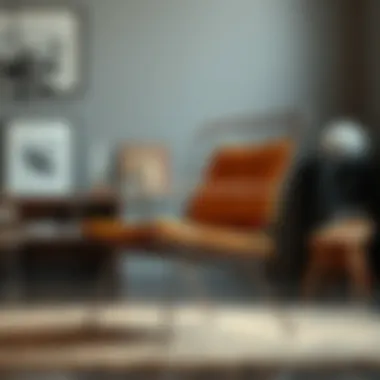Exploring the Steel Armchair: Design and Durability


Intro
The steel armchair stands at a fascinating junction between resilience and design, marrying form and function in a way that's rare in the world of furniture. As contemporary aesthetics evolve, the armchair's steel frame speaks to both strength and elegance. Homeowners and designers alike are increasingly drawn to the sleek lines and versatile finishes offered by this piece. Rather than merely being a place to sit, the steel armchair has become a statement piece, whispering (or sometimes shouting) its stylistic intentions throughout modern interiors.
This guide seeks to dissect the broader themes surrounding the steel armchair by exploring its historical implications, design variations, and the burgeoning market trends that determine its place in today’s homes. Emphasizing sustainability and usability, we will take a holistic view that covers everything from materials to effective care tips.
Furniture Styles and Trends
Modern vs. Traditional: Understanding the Aesthetics
The contrast betwen modern and traditional styles plays a significant role in the perception and adoption of steel armchairs. Modern designs typically flaunt minimalist aesthetics with clean lines and stark colors, often seamlessly blending with industrial backdrops. This style speaks to the current generation’s inclination towards simplicity paired with an edge, fostering environments that thrum with understated elegance. Yet, traditional designs take a more ornate approach, featuring intricate detailing and warm finishes. In these settings, steel armchairs can complement the classic vibe, offering a juxtaposition that exudes sophistication while remaining up to date.
Key Aesthetic Differences:
- Materials: Modern often favors raw, unpolished tones, while traditional may lean towards cushioned options with fabric embellishments.
- Colors: Steel armchairs can be seen in monochromatic palettes for modern homes whereas traditional settings embrace warmer hues.
- Form: The form factor of modern armchairs generally showcases angular designs compared to the softer, rounded edges found in traditional pieces.
Color and Material Trends: What's In and What's Out
As we navigate through trends, it’s clear that colors and materials of steel armchairs are evolving. Up-and-coming is the trend of matte finishes that offer a subtle sophistication compared to the shiny counterparts of yesteryears. Earthy tones have also gained traction, softening the sharpness of steel, further inviting comfort into a space. The use of environmentally-friendly finishes is indeed what's hot right now, resonating with a more conscious consumer base.
Conversely, overly elaborate embellishments and vibrant hues are on their way out, making space for simplicity and durability over ornate aesthetics. Additionally, synthetic materials that do not convey longevity are being replaced as consumers prioritize quality and sturdiness over fleeting trends.
"The longevity of design relies heavily on material choices more than anything else. A well-constructed steel armchair will not only hold its place within a room but also withstand the test of time."
Furniture Care and Maintenance
Tips for Prolonging the Life of Your Furniture
To ensure that your steel armchair serves well into the future, care plays a pivotal role. Regular cleaning is essential; simply wipe it down with a damp cloth to remove dust and dirt.
- Protect from Excessive Moisture: Keep away from damp areas as rust can be a hidden enemy.
- Avoid Direct Sunlight: Prolonged exposure not only fades color but can warp or damage structure.
- Use a Furniture Polish: A quality polish can enhance the sheen and protect the finish, helping to maintain its new look.
DIY Repair Hacks for Common Furniture Issues
Even the sturdiest armchair can face hiccups along the way. Here are some practical DIY fixes:
- Scratch Repair: For minor scratches, rubbing a bit of metal polish can work wonders, rejuvenating the surface.
- Rust Treatment: Remove rust spots with a mixture of vinegar and baking soda. Apply, scrub gently, and rinse to restore the chair’s finish.
Such small efforts can drastically enhance the longevity and appeal of your steel armchair, ensuring it remains a functional piece of art in your living space.
In summation, understanding the nuances tied to the steel armchair helps forge connections between aesthetic choice and functional integrity. This article will continue to explore deeper into manufacturing techniques, market trends, and how the vibrant world of steel armchairs can enhance modern residential landscapes.
Preamble to Steel Armchairs
When one considers the world of furniture design, steel armchairs are often overshadowed by softer alternatives. However, their importance in both aesthetic and functional contexts cannot be overstated. The appeal of steel armchairs lies not just in their robust construction but also in their versatility that adapts to various design philosophies. From modern lofts to traditional spaces, these pieces offer a unique balance between artistry and practicality.
Definition and Characteristics
Steel armchairs can be defined as seating structures made primarily from steel, accompanied by various finishes and seat materials. Defining features of these armchairs typically include their strength, resilience, and contemporary aesthetic. Steel as a material contributes immensely to the longevity of the chair, ensuring it can withstand wear and tear in busy environments. Many models showcase clean lines and geometric forms, making them suitable for minimalist and industrial designs.
Furthermore, their weight is an essential characteristic, providing stability and a grounding effect in a room. Interestingly, the integration of cushioning and fabric upholstery can soften the starkness of steel, making for a balanced romanticism in design.
Historical Significance


The journey of steel armchairs dates back to the industrial revolution when advancements in metalworking allowed for new possibilities in furniture design. The introduction of steel into domestic spaces marked a significant shift, as designers began exploring its capabilities and aesthetic potential.
One notable milestone occurred during the early 20th century, when architects like Ludwig Mies van der Rohe began experimenting with steel. His iconic Barcelona chair exemplifies how steel can be transformed into a sophisticated piece of art, changing the perception of metal furniture forever.
In fact, these chairs have become symbols of modernity, reflecting the evolution of design as societies moved away from traditional craftsmanship towards industrialization. As such, steel armchairs are not only furniture; they are a testament to cultural shifts and innovations in design, celebrating both function and form.
“The significance of steel furniture stems not just from its functionality but also from its ability to evolve with societal needs and aesthetic sensibilities.”
In summary, understanding the definition and historical background of steel armchairs lays the foundation for appreciating their nuanced place in contemporary design. They evoke a timeless sense of style that continues to captivate homeowners and designers alike.
Design Variations
The steel armchair, a striking blend of functionality and style, showcases a spectrum of design variations that resonate across different aesthetic sensibilities. Understanding the nuances of these variations not only enhances appreciation for this ubiquitous piece of furniture but also aids homeowners and designers in making informed choices that align with their stylistic preferences and interior needs. Each design variation carries a weight of history, purpose, and visual appeal that contributes to its uniqueness and relevance in contemporary settings.
Industrial Design
Industrial design stands as one of the most compelling iterations of the steel armchair. Characterized by the raw aesthetic of exposed materials and functional forms, this style often emphasizes simplicity and utility over ornamentation. Made with unadorned steel, these chairs serve as perfect complements to lofts and modern offices where an unfinished look blends seamlessly with minimalistic decor.
The beauty of industrial steel armchairs lies in their versatility. They can effortlessly fit into various spaces—be it a trendy café or a cozy home study. For instance, an industrial steel chair paired with reclaimed wood tables injects warmth into a cool, industrial aesthetic, showcasing a striking contrast. These designs have a latent practicality: they often resist wear and tear better than their wooden counterparts and are easier to clean, making them ideal for high-traffic areas.
Mid-Century Modern Styles
Shifting gears to mid-century modern styles, the steel armchair adopts a different persona, reflecting the bold yet functional designs of the mid-20th century. This era is celebrated for its commitment to integrating form and function, where chairs sport sleek lines, innovative structures, and vibrant colors. In this context, steel is often combined with other materials, such as wood or plastic, to create a harmonious balance.
Mid-century modern steel armchairs often feature cannot-leave-behind elements like organic shapes and delicate yet sturdy frames that act visually light even though they are made from a robust material. Think of the iconic Eames Lounge Chair: a masterpiece that weds molded plywood with steel. The charm of this style lies in its timelessness, making it equally appealing to those with a taste for nostalgia and modernity alike.
"The clean lines and uncomplicated design of mid-century modern chairs speak to a simplicity that resonates with the contemporary aesthetic."
Contemporary Trends
As we enter the realm of contemporary trends, steel armchairs become a canvas for avant-garde designs and experimental aesthetics. Here, creativity knows no bounds, as designers incorporate unexpected shapes, bright colors, and innovative materials to enhance the originality of steel armchairs. Think of geometric frames or sculptural components that challenge traditional notions of seating.
The goal of contemporary steel armchair design often centers around personalization and expressive styles. For instance, brands like Knoll and Herman Miller offer customization options, allowing consumers to choose colors and finishes that suit their taste. This adaptability not only supports individual preferences but also aligns with the growing trend toward bespoke furniture.
By focusing on the essence of contemporary design, manufacturers increasingly emphasize sustainable practices in their production processes, introducing eco-friendly finishes or recycled materials. This reflects a growing awareness among consumers towards not only aesthetics but the ethical implications of their design choices.
In summation, the design variations of steel armchairs span a diverse range, from industrial grit to mid-century elegance and contemporary flair. Each style offers its own set of benefits and considerations, which can significantly impact the overall feel of a space. For homeowners, designers, and enthusiasts alike, recognizing these distinctions is pivotal in making thoughtful choices that enhance functionality and aesthetic value.
Material Considerations
When discussing steel armchairs, it’s crucial to address the material considerations. The choice of materials not only influences the chair's durability but also impacts its aesthetics and functional performance. Understanding these materials can benefit homeowners, designers, and enthusiasts alike, ensuring they select the right armchair for their specific needs.
Types of Steel Used
Steel is a versatile material, and various types are utilized in the manufacturing of armchairs, each with its own unique properties:
- Mild Steel: This type of steel is commonly used in furniture design due to its malleability and weldability. It can be shaped easily and is often finished with paint or powder coating to enhance its appealing looks.
- Stainless Steel: Known for its resistance to rust and corrosion, stainless steel contributes to longevity. It shines, adding a modern flair while still ensuring robust construction. This material is particularly favored for outdoor settings or high-moisture environments.
- Galvanized Steel: This is coated with zinc to prevent rust. Galvanized options deliver durability in climates that experience harsh weather conditions, making them suitable for outdoor spaces without worrying about deterioration.
Choosing the right type of steel based on where and how the armchair will be used is essential. Each kind carries specific benefits and potential drawbacks that should align with the user's lifestyle and preferences.
Finish and Coatings
The finish and coatings applied to steel armchairs play a pivotal role in determining their look and resilience. A few noteworthy options include:


- Powder Coating: This provides a thick, protective layer that is remarkably durable and comes in an array of colors. It resists chipping, scratching, and fading, ensuring that chairs maintain their vibrancy over time.
- Liquid Coating: Although not as thick as powder coating, this method allows for smooth finishes and detailed designs. This is often used to achieve a more refined appearance with texture and patterns that can enhance aesthetic appeal.
- Natural Finish: For a more industrial vibe, leaving steel in its natural finish is sometimes preferred, offering a raw look. This must be maintained with proper care to prevent rust, which can easily compromise the armchair's integrity.
A careful consideration of finishes and coatings enhances both the visual style and the lifespan of the steel armchair. Homeowners should think about how much wear and tear the chair will endure and select a finish accordingly.
In summary, the materials used in creating steel armchairs contribute significantly to their overall appeal and function. Understanding the different types of steel and finishes empowers consumers to make informed choices that harmonize their personal style with practicality.
For more insights on sustainable materials, consider exploring resources such as EPA.gov or Wikipedia for detailed explanations on the properties and applications of different steel types.
Functionality and Comfort
When it comes to furniture, functionality and comfort are non-negotiable. The steel armchair, with its robust design, not only serves as a striking element in modern decor but also meets the practical needs of users. This section elaborates on why these qualities are essential, how they influence consumer choices, and the overall effectiveness of steel armchairs in day-to-day life.
Ergonomic Features
The modern world is more aware of the importance of ergonomics than ever before. Steel armchairs often incorporate ergonomic designs that cater to the human form. These features promote better posture and reduce the risk of discomfort during prolonged use.
Some key ergonomic aspects abound in contemporary steel armchairs:
- Lumbar Support: Many designs feature built-in back support that conforms to the natural curve of the spine, alleviating back pain.
- Adjustable Components: An increasing number of models allow for adjustable seat height and tilt, enabling users to find their ideal seating position.
- Contoured Seating: The seat’s surface can be shaped to cradle the body better, providing a more comfortable experience.
These ergonomic details not only enhance comfort in residential spaces but also make steel armchairs suitable for commercial environments like offices and cafes, where people often sit for extended periods.
"A well-designed chair should invite the user to sit, and support them comfortably through long periods," reflects many designers today.
Applications in Different Settings
The versatility of steel armchairs allows them to shine in a range of settings, each of which highlights their functional benefits:
- Home Use: In the living room or on the patio, steel armchairs can serve as durable seating for family and friends. Their robustness makes them resistant to spills and wear, perfect for households with children or pets.
- Workplace Environments: In offices, steel armchairs equipped with ergonomic features promote productivity. They provide comfortable seating that encourages focus during long hours of work.
- Public Spaces: Parks and open-concept public areas often benefit from steel armchairs designed for outdoor use. Their durability against the elements makes them a preferred choice for urban planners.
- Cafés and Restaurants: Here, the aesthetic appeal combined with comfort translates to a welcoming atmosphere, leading to prolonged customer visits, enhancing the overall dining experience.
Sustainability and Environmental Impact
The conversation surrounding furniture often includes discussions on sustainability, and the steel armchair is no exception. With growing awareness about environmental issues, consumers increasingly search for products that marry functionality with sustainability. Steel armchairs present several benefits in this regard, drawing attention to their sustainable sourcing and recyclability, which are critical in today’s marketplace.
Firstly, embracing sustainability in design not only reflects a commitment to the planet but also enhances product appeal among discerning buyers. This section delves deeply into the eco-friendly aspects of steel armchairs, underlining their significance in a world grappling with climate change and resource depletion.
Sustainable Sourcing of Materials
Steel, by its nature, is a material that offers advantages when sourced sustainably. Manufacturers are making leaps in responsible sourcing practices, ensuring that the steel used in armchairs is obtained from ethical avenues. This can include recycled steel, which significantly reduces the energy and raw materials required to produce new steel. Using recycled materials curtails waste and lowers the carbon footprint associated with furniture creation.
The journey of a steel armchair can begin with sourcing scrap steel from both industrial and consumer waste. Additionally, some companies are opting to procure steel from sources that prioritize minimal environmental impact. This responsible sourcing embraces transparency, signaling to consumers that their purchase contributes to sustainable manufacturing practices.
Promoting sustainable methods of acquiring materials also appeals to customers who are increasingly keen on knowing the origins of their purchases. Brands that highlight their commitment to sustainable sourcing thus gain a reputation that resonates well within today's eco-conscious market.
Recyclability of Steel
Another cornerstone of the armchair's environmental credentials is the recyclability of steel. Once a steel armchair has served its purpose in a home or office, its lifecycle doesn't necessarily end there. In fact, steel can be recycled indefinitely without compromising its strength or quality. The process is simpler than one might imagine; post-consumer steel can be melted down and remolded into new products, ranging from construction materials to household items.
This encourages a circular economy, minimizing waste and maximizing the use of materials already in circulation. An individual purchasing a steel armchair doesn’t just buy a piece of furniture; they invest in a product that holds its value over time and contributes to a sustainable future. Moreover, recycling steel consumes far less energy compared to producing new steel from ore, highlighting a compelling economic advantage alongside its environmental benefits.
"The choice of materials in furniture design today directly impacts the environment of tomorrow."
For more on sustainable design practices, check out resources at Wikipedia and Britannica.


Market Trends and Consumer Preferences
Understanding current market trends and consumer preferences is crucial for anyone involved in the design and retail of steel armchairs. In today’s fast-paced world, a growing number of consumers are looking for furniture that not only serves a purpose but is also in tune with their personal style and ethics. The steel armchair has found its niche as it seamlessly blends functionality with aesthetic appeal. This section delves into two significant trends: demand for customization and emerging designs that are capturing the market's imagination.
Demand for Customization
The appetite for customization has surged in various industries, and furniture design is no exception. Homeowners and design enthusiasts alike seek pieces that reflect their individuality, moving away from cookie-cutter solutions. Steel armchairs, with their robust material and versatile shapes, are a perfect candidate for personalization. Consumers now want to choose not just the color or finish but also specific dimensions and style elements.
- Tailored Aesthetics: Many brands now offer the ability to change upholstery options, adjust seating height, or modify armrest styles. For the discerning buyer, this means their steel armchair can be as unique as they are.
- Eco-Conscious Choices: Some consumers prioritize sustainability. With a greater focus on eco-friendly materials, customization helps in choosing upholstery that is made from recycled or sustainable sources, marrying personal taste with environmental awareness.
"Customization gives consumers not only a product but a narrative they can own. Each chair tells a story of the earner's taste and choices."
Steel armchairs that come with customizable options help brands stand out. Companies that embrace this trend are likely to foster loyalty among their clientele, who appreciate meaningful engagement in design.
Emerging Designs in the Marketplace
As market dynamics shift, emerging designs in steel armchairs are reshaping the landscape. Innovative ideas are flowing from both established manufacturers and independent designers, leading to a remarkable array of styles.
- Sculptural Forms: More designers are creating sculptural steel armchairs that can serve as centerpieces in modern homes. These designs often combine curves and angles that are visually striking yet fully functional. An example includes the Steelcase Gesture chair, known for its adaptable features while making a bold aesthetic statement.
- Minimalism Meets Function: Brands like Muuto push forward with minimalistic designs that focus on functionality without compromising style, often integrating smart features such as stacking for easier storage.
- Hybrid Materials: A trend worth noting is the combination of steel with other materials. Consider armchairs that utilize natural wood or fabrics together with steel frames, offering a balance between warmth and industrial chic.
Care and Maintenance of Steel Armchairs
Caring for your steel armchair is much more than just keeping it clean; it’s about preserving its aesthetics and structural integrity over time. In the grand scheme of furniture ownership, regular maintenance signals respect not only for your investment but also for the craft that went into its creation. A well-maintained armchair can serve you loyally for decades, blending functionality with style in your home. Whether you have a vintage piece or a sleek contemporary design, understanding how to care for these sturdy chairs enhances their longevity and appeal.
Cleaning Techniques
When it comes to cleaning, a little goes a long way. Steel armchairs often collect dust and grime, particularly in high-traffic areas or kitchens. Here are some effective strategies to keep your chair looking brand new:
- Use Soft Cloths: A microfiber cloth works wonders. Avoid anything too rough, as this can scratch the surface.
- Gentle Soaps: If dirt is stubborn, mix mild soap with water and apply with a damp cloth. Rinse with a clean, damp cloth afterward.
- Spot Cleaning for Fabrics: If your chair has fabric cushions, spot cleaning with fabric-friendly cleaners can prevent stains from setting in.
- Avoid Harsh Chemicals: Products containing bleach or ammonia can tarnish the surface or damage the finish. Stick with gentle cleaners.
Keeping the touchpoints of your steel armchair clean not only maintains its function but also contributes to a pleasant ambiance in your room.
Preventing Corrosion and Damage
One of the primary concerns for any steel furniture is corrosion, especially if exposed to moisture. Preventing such damage is paramount. Here’s how to fortify your steel armchair against wear and tear:
- Regularly Inspect: Keep an eye out for any scratches or chips. Once you see one, it’s crucial to address it immediately.
- Apply Protective Coating: Consider using a wax or a sealant designed for metal. This can provide an extra layer of protection against moisture and dirt.
- Store Properly: If you need to store your armchair, make sure it's in a dry place. Cover it if there's a risk of dust accumulation.
- Use Coasters and Place Mats: If you are placing items on your armchair, such as drinks or plates, using coasters and mats helps to prevent rings and stains.
Maintenance is not just about prevention; it's an investment in longevity. By protecting your steel armchair from corrosion and damage, you ensure it remains a staple in your living space for years to come.
The End
The conclusion serves as a crucial component in understanding the significance of the steel armchair in contemporary design. Synthesizing the various elements discussed throughout this article, it reinforces the value these chairs bring to both aesthetic appeal and functional capability in modern living spaces. As trends continue to evolve, the resonant qualities of steel armchairs remind us of their powerful blend of durability and elegance.
The Future of Steel Armchairs in Design
As we look to the future, the steel armchair stands poised to adapt to emerging design philosophies. Innovations in fabrication techniques are enabling designers to play with shapes, sizes, and finishes in ways previously unimagined. The use of artificial intelligence in design is also becoming more prominent, encouraging personalized designs tailored to individual preferences. Factors such as sustainability will likely continue to influence both material choices and the overall manufacturing processes. With increasing consumer awareness about environmental issues, steel manufacturers are now seeking to minimize waste and leverage recycled metals.
In addition, we can expect a push towards integrating technology into furniture design. Imagine smart steel armchairs equipped with built-in charging stations or even health-monitoring systems. It may sound futuristic, but as technology progresses, so will our expectations for what furniture can offer. Therefore, the steel armchair isn’t just a passive element of decor but is evolving to enhance our lifestyles further and play a significant role in redefining comfort and utility in the home.
A Reflection on Their Enduring Appeal
Steel armchairs possess an enduring appeal that transcends trends and fleeting design fads. Their solid construction provides a sense of permanence, often becoming heirlooms that tell stories across generations. The versatility of these chairs is evident in their widespread application, from upscale dining establishments to cozy home settings. Additionally, the potential for customization allows homeowners to infuse their personality into their spaces, creating a unique ambiance.
Moreover, the minimalist aesthetic frequently associated with steel armchairs has led to their compatibility with various decor styles—be it industrial, vintage, or contemporary. Their ability to harmonize or contrast with other materials, such as wood or textiles, makes them a darling of designers and DIY enthusiasts alike.
Ultimately, steel armchairs encapsulate the relationship we share with our environments. They are not merely furniture pieces but embodiments of practical artistry, marrying form with function. As we advance, it is evident that the appreciation for these remarkable pieces of design will only deepen.
"In a world of fleeting trends, steel armchairs offer a touch of stability and style, emerging not just as seating options, but as fundamental components of a thoughtfully crafted space."















